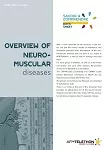Mots-clés
 > MYOBASE > SANTE > médecine > maladie > maladie par appareil > maladie de l'appareil locomoteur > maladie neuromusculaire > maladie neuromusculaire par protéine > PABPN1 (maladie neuromusculaire liée à) > dystrophie musculaire oculopharyngée > MYOBASE > SANTE > médecine > maladie > maladie par appareil > maladie de l'appareil locomoteur > maladie neuromusculaire > maladie neuromusculaire par protéine > PABPN1 (maladie neuromusculaire liée à) > dystrophie musculaire oculopharyngée
dystrophie musculaire oculopharyngée
Commentaire :
Sur le chromosome 14.
Répétition, en petit nombre, d'un triplet GCG sur le gène codant la protéine PABPN1 ou PABP2 (poly(A)-binding protein-2). Transmission autosomique dominante. Fréquence : 1 /100 000 en France, plus fréquente au Québec Gène PABPN1/14q11.2-q13 Protéine PABP1 protéine nucléaire de liaison aux résidus polyalanines ORPHA 270 OMIM : 164300 Sources : Principales maladies neuromusculaires, octobre 2011, Fiche Technique Savoir et Comprendre, AFM Avancées médico-scientifiques neuromusculaires, juin 2011, Fiche Technique Savoir et Comprendre, AFM Synonyme(s)DMOP ;dystrophie musculaire oculo-pharyngée ;dystrophie musculaire oculopharyngée ;myopathie oculopharyngée ;syndrome oculo-pharyngé ;oculopharyngeal dystrophy ;oculopharyngeal syndrome ;ODP ;OPMD oculopharyngeal muscular dystrophyVoir aussi |
Documents disponibles dans cette catégorie (399)
 trié(s) par (Date de parution décroissant(e), Date de parution décroissant(e), Système de projection du document croissant(e)) | Mettre toutes les notices dans le panier | Faire une suggestion | Ajouter un critère de recherche
trié(s) par (Date de parution décroissant(e), Date de parution décroissant(e), Système de projection du document croissant(e)) | Mettre toutes les notices dans le panier | Faire une suggestion | Ajouter un critère de rechercheEtendre la recherche sur niveau(x) vers le bas

Article
Brisson JD ; Brais B ; Mathieu J ; Lessard I ; Gagné-Ouellet V ; Cote I ; Gagnon C | 17/10/2023
Article
Smith IC ; Chakraborty S ; Bourque PR ; Sampaio ML ; Melkus G ; Lochmuller H ; Woulfe J ; Parks RJ ; Brais B ; Warman-Chardon J | 06/10/2023
Publication AFM
Bichat M, Auteur ; Cukierman L, Auteur ; S Marion, Auteur ; Maxime E, Auteur ; Schanen-Bergot MO, Auteur ; S Marion, Concepteur ; Schanen-Bergot MO, Concepteur | AFM-TELETHON | Savoir & Comprendre | 10/2023Dans cette Fiche Technique Savoir & Comprendre sont répertoriés des essais cliniques, études observationnelles et registres qui concernent les maladies neuromusculaires et qui sont soit en préparation, soit en cours. Les informations sont issues[...]
Article
Middelink M ; Voermans NC ; van Engelen BGM ; Janssen MCH ; Groothuis JT ; Knuijt S ; Zweers-van Essen H | 15/07/2023
Article

Article

Article

Publication AFM
Brignol TN ; Urtizberea JA ; Rivière H ; Gilby E | AFM-TELETHON | Fiche Technique Médico-Scientifique Savoir & Comprendre | 03/2023After a brief reminder of the structure of the motor unit and the various modes of inheritance, this document provides short descriptions of the neuromuscular diseases that are part of our scope at AFM-Téléthon, as well as how to manage and trea[...]
Publication AFM
Brignol TN, Auteur ; Urtizberea JA, Auteur ; Rivière H | AFM-TELETHON | Fiche Technique Médico-Scientifique Savoir & Comprendre | 03/2023Après un bref rappel de la structure de l’unité motrice et des différents modes de transmission génétique, ce document présente une description succincte des principales maladies neuromusculaires et de leur prise en charge. Pour chaque groupe [...]
Article
Takahashi Y ; Morimoto N ; Nada T ; Morimoto M ; Eura N ; Minami N ; Nishino I | Netherlands | 18/02/2023
Article

Article

Article
Ogasawara M ; Eura N ; Iida A ; Kumutpongpanich T ; Minami N ; Nonaka I ; Hayashi S ; Noguchi S ; Nishino I | England | 07/12/2022
Publication AFM
Bichat M, Auteur ; Cukierman L, Auteur ; S Marion, Auteur ; Maxime E, Auteur ; Schanen-Bergot MO, Auteur ; S Marion, Concepteur ; Schanen-Bergot MO, Concepteur | AFM-TELETHON | Savoir & Comprendre | 12/2022Dans cette Fiche Technique Savoir & Comprendre sont répertoriés des essais cliniques, études observationnelles et registres qui concernent les maladies neuromusculaires et qui sont soit en préparation, soit en cours. Les informations sont issues[...]
Article
Roth F ; Dhiab J ; Boulinguiez A ; Mouigni HR ; Lassche S ; Negroni E ; Muraine L ; Marhic A ; Oliver A ; Laine J ; Rouche A ; O'Ferrall EK ; van Engelen B ; Ottenheijm C ; Greif H ; Blumen S ; Lacau St Guily J ; Perie S ; Butler-Browne G ; Mouly V ; Trollet C | Germany | 05/10/2022
Article
Melkus G ; Sampaio ML ; Smith IC ; Rakhra KS ; Bourque PR ; Breiner A ; Zwicker J ; Lochmuller H ; Brais B ; Warman-Chardon J | England | 02/10/2022






